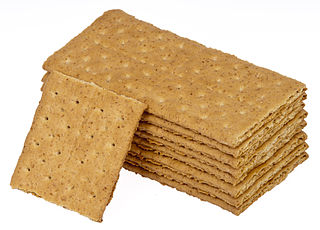
A graham cracker is a sweet flavored cracker made with graham flour that originated in the United States in the mid-19th century, with commercial development from about 1880. It is eaten as a snack food, usually honey- or cinnamon-flavored, and is used as an ingredient in some foods, e.g., in the graham cracker crust for cheesecakes and pies.

Hardtack is a type of dense cracker made from flour, water, and sometimes salt. Hardtack is inexpensive and long-lasting. It is used for sustenance in the absence of perishable foods, commonly during long sea voyages, land migrations, and military campaigns. Along with salt pork and corned beef, hardtack was a standard ration for many militaries and navies from the 17th to the early 20th centuries.
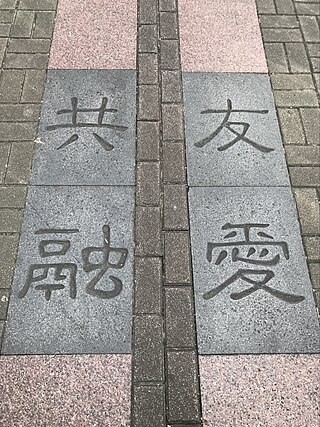
The culture of Hong Kong is primarily a mix of Chinese and Western influences, stemming from Lingnan Cantonese roots and later fusing with British culture due to British colonialism. As an international financial center dubbed "Asia's World City", contemporary Hong Kong has also absorbed many international influences from around the world. Moreover, Hong Kong also has indigenous people and ethnic minorities from South and Southeast Asia, whose cultures all play integral parts in modern-day Hong Kong culture. As a result, after the 1997 transfer of sovereignty to the People's Republic of China, Hong Kong has continued to develop a unique identity under the rubric of One Country, Two Systems.

Cheez-It is a brand of cheese crackers manufactured by Kellanova through its Sunshine Biscuits division. Approximately 26 by 24 mm, the rectangular crackers are made with wheat flour, vegetable oil, cheese, skim milk, salt, and spices.
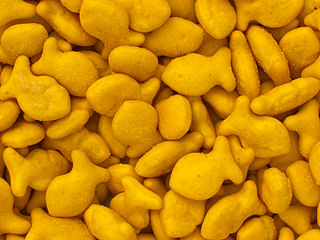
Goldfish is a brand of fish-shaped cracker with a small imprint of an eye and a smile manufactured by Pepperidge Farm, which is a division of the Campbell Soup Company. The brand's current marketing and product packaging incorporate this feature of the product: "The Snack That Smiles Back! Goldfish!", reinforced by Finn, the smiling goldfish mascot with sunglasses. The product is marketed as a "baked snack cracker" on the label with various flavors and varieties.

A rice cracker is an East Asian cracker made from bleached or unbleached rice flour. Many regional varieties exist, though most are fried or baked and puffed and/or brushed with soy sauce or vinegar to create a smooth texture. Some may also be wrapped in seaweed.
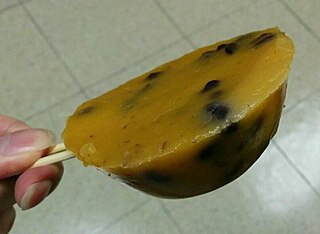
Put chai ko is a popular snack in Hong Kong. It is a rice cake made from white or brown sugar, long-grain rice flour with a little wheat starch or cornstarch. Sometimes red beans are also added. The batter is poured into porcelain bowls and steamed until cooked through. Then it is allowed to cool and served at room temperature. Traditionally, the hawker inserts two bamboo skewers into the cake to turn it out and the eater holds the skewers to consume. At present, most put chai ko are sold in plastic bags.

Want Want Holdings Limited is a food manufacturer and media corporation from Taiwan. It is one of the largest rice cake and flavored drink manufacturers in Taiwan. It engages in the manufacturing and trading of snack foods and beverages, divided into four businesses: rice crackers, dairy products, beverages, snack foods, and other products. It operates over 100 manufacturing plants in mainland China and 2 in Taiwan, and employs over 60,000 people.

An egg waffle is a spherical egg-based waffle popular in Hong Kong and Macau, consisting of an eggy leavened batter cooked between two plates of semi-spherical cells. They are usually served hot, and often eaten plain, although they may be served with fruit and flavors such as strawberry, coconut or chocolate. It is referred to by its original Cantonese name, gai daan jai (雞蛋仔), and in English, an egg puff, bubble waffle, eggette, pancake balls, pancake waffle, egglet, and puffle. They are sometimes referred to as Hong Kong cakes in Chinatowns across America, especially in New York. One piece of egg waffle can have around 20 to 35 small round 'balls'.
Nantong Xiting Cracker, also possibly known as sesame seed cake, is one of the specialties of Nantong. It is known for the quality of its ingredients and the meticulous preparation involved in its production.
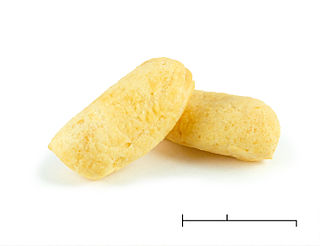
Amplang, also known as kerupuk kuku macan, is an Indonesian traditional savoury fish cracker snack commonly found in Indonesia and Malaysia. Amplang crackers are commonly made of ikan tenggiri (wahoo) or any type of Spanish mackerel, mixed with starch and other materials before being deep-fried.

Bing sutt is a type of traditional cold drinking house started in Guangzhou (Canton) that spread to Hong Kong. These bing sutts arose in the 1950s and 1960s. They are characterized by old furniture and settings such as the small tiled floors, hanging fans, folding chairs and so on. A bing sutt provides light meals and drinks and is neighbourhood-oriented. It is believed to be the predecessor of the cha chaan teng.

Hong Kong street food is characterised as the ready-to-eat snacks and drinks sold by hawkers or vendors at food stalls, including egg tarts, fish balls, egg waffles and stinky tofu, according to the definition provided by the Food and Agriculture Organization. They can be found throughout the city, especially in the areas of Mong Kok, Causeway Bay, Yuen Long, Tsuen Wan, and Kwun Tong.

Korean Street, also known as Little Korea, is a Koreatown in Hong Kong located primarily on Kimberley Street in Tsim Sha Tsui. A compact community of Koreans have lived in this area since the 1960s, and there is a concentration of Korean shops opened by Koreans, such as Korean restaurants and grocery stores. There are at least sixteen Korean food shops in Kimberly Street.

Putting traditional candies into a Chinese candy box is a custom of Hong Kong people at Chinese New Year. In fact, there is a hidden meaning in this practice. It is said that people believe sweet candies symbolize an appealing and delightful start to the new year.

Fish crackers are deep-fried crackers made from fish and spices, originating from Indonesia. The crackers are made mainly with tapioca flour and/or sago flour and then salt, sugar, and MSG as seasonings. Fish crackers can be found throughout Southeast Asia and East Asia. However, they are more commonly found and of greater variety in Indonesia and Malaysia.

Prawn crackers are a deep-fried snack made from starch and prawn. They are a common snack food in Southeast Asian cuisine, but they are most closely associated with Indonesia. They have also been adapted into East Asian cuisines, where the similar Japanese kappa ebisen (かっぱえびせん) and Korean saeukkang are popular snacks.
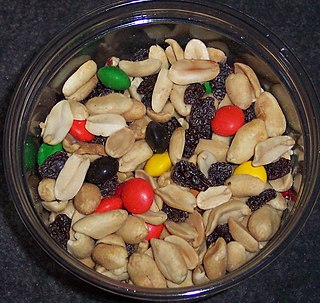
A snack is a small portion of food generally eaten between meals. A snack is often less than 200 calories, but this can vary. Snacks come in a variety of forms including packaged snack foods and other processed foods, as well as items made from fresh ingredients at home.

Haipai cuisine is a Western-style cooking that is unique to Shanghai, China. It absorbs the traditions of several cuisines from other regions of China and of Western cooking, adapting them to suit the local taste according to the features of local ingredients. It is divided into several major types: French, Italian, Russian, British, and German, among which the Russian-type dishes, such as the Shanghai-style borscht, receive a great welcome as they are more affordable. Today, the most famous dishes of Haipai cuisine are luó sòng tāng, fried pork chops, and Shanghai salad. Apart from the above-mentioned common dishes, baked clams, baked crabs, and jin bi duo soup are also popular among the Haipai dishes.


















